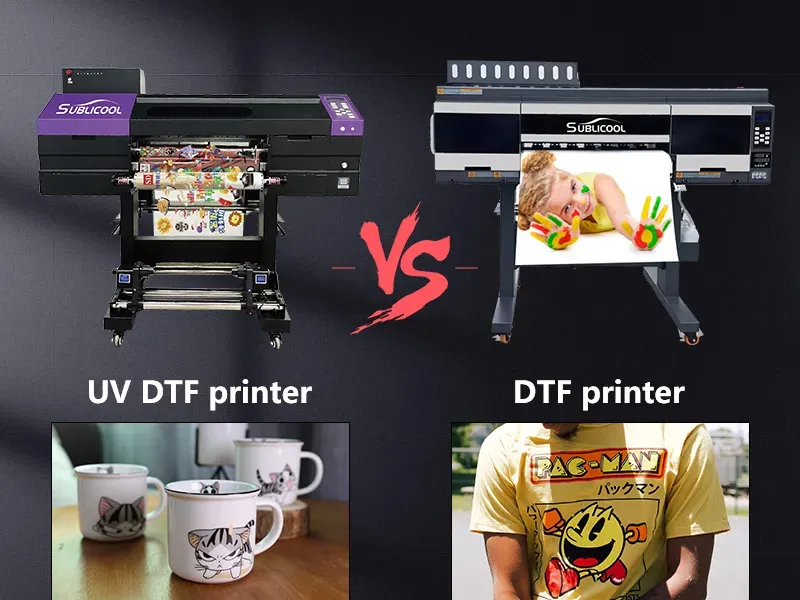When it comes to garment printing, the choice between **UV DTF vs Standard DTF** can significantly influence the outcome of your projects. Both printing methods leverage advanced technologies to produce vibrant designs, yet they differ in their approach and application. **UV printing technology** is revolutionizing the industry with its ability to cure inks instantly, leading to durable outputs, while **Standard DTF printing** remains a staple for textile applications with its water-based inks. Each method presents unique benefits, making it essential to understand their capabilities, especially in the realm of digital printing. As businesses explore their options, comparing these two methods will help them harness the advantages of **UV-cured inks** or the tried-and-true methods of Standard DTF.
Exploring the realm of **direct-to-film printing**, you’ll encounter two primary techniques: Ultraviolet Direct to Film (UV DTF) and conventionally known Direct to Film (Standard DTF). These methods have reshaped **garment printing** by accommodating diverse materials and production requirements. UV DTF stands out with its ability to produce high-resolution prints on various substrates thanks to its advanced curing process, while Standard DTF remains prevalent among fabric print enthusiasts for its simplicity and effectiveness. Understanding these technologies’ nuances is crucial for making informed choices in the fast-evolving landscape of digital printing. Choosing the right method can enhance not only product quality but also customer satisfaction, driving business success in the competitive printing market.
The Fundamentals of DTF Printing
DTF printing, or Direct to Film printing, has revolutionized the fabric and garment printing sectors through its innovative approach to transferring designs. This technique primarily involves printing an image onto a specially coated film, which can then be applied to various substrates. As a versatile printing solution, DTF printing caters to a wide array of materials, including textiles like cotton and polyester. The method leverages advanced digital printing techniques, using specialized inks that bond effectively with fabric, ensuring a high-quality finish that meets the demands of modern consumers.
Within the realm of DTF printing, two primary technologies stand out: Standard DTF and UV DTF. Each method offers unique attributes that cater to diverse needs in the printing industry. Standard DTF typically operates using water-based inks, which are eco-friendly and provide flexible applications on fabric. Conversely, UV DTF employs UV-curable inks, enhancing the capability to print not only on cloth but also on hard surfaces like glass and metals. This differentiation is crucial for businesses looking to expand their product range and attract varied customer demographics.
Standard DTF Printing Overview
Standard DTF printing employs a straightforward technique that hinges on water-based inks and a heat transfer process. After printing the design onto the film, an adhesive powder is applied, enabling the image to be seamlessly transferred to the intended fabric. This method is particularly advantageous for companies focused on garment printing, as it efficiently produces vibrant designs that adhere well to cotton, blends, and synthetic fabrics. However, while it is effective for various textiles, it may not stand up as well under rigorous wear, resulting in potential fading or cracking over time.
Users of Standard DTF should be aware of both its strengths and limitations. Its primary advantage lies in the ease of use and the quality of prints on soft materials. However, the longevity of these prints can sometimes be compromised when exposed to environmental conditions, especially sunlight or frequent washing. Consequently, as businesses weigh their options, understanding these potential drawbacks is essential to ensure alignment with their product offerings and customer expectations.
Deep Dive into UV DTF Technology
UV DTF technology is making significant strides in the printing industry, setting itself apart through the use of UV-cured inks. This innovative approach not only enhances the vibrancy of color output but also ensures immediate curing of designs as they are printed. The result is an extremely durable finish capable of withstanding considerable wear and tear. This property makes UV DTF particularly appealing to businesses that seek long-lasting prints, such as promotional products, signage, and apparel designed for outdoor use.
Furthermore, UV DTF’s versatility is a game-changer in the printing landscape. Unlike Standard DTF, which primarily focuses on fabric, UV DTF can effectively print on a variety of substrates, including plastic, wood, glass, and metal. This wide-ranging application allows for greater creativity and diversification in product offerings, meeting the growing consumer demand for unique and customized printing solutions. As businesses explore ways to stand out in a competitive market, the adaptability provided by UV DTF technology becomes increasingly valuable.
Comparing Durability: UV DTF vs Standard DTF
When it comes to durability, there’s a compelling distinction between UV DTF and Standard DTF printing. The UV-cured inks utilized in UV DTF technology provide exceptional scratch resistance and tend to maintain their vibrancy over time, even under harsh environmental conditions. This makes UV DTF a preferred choice for applications where durability is paramount, such as items that are regularly exposed to sunlight or physical handling. Businesses aiming for long-lasting quality may find that the initial investment in UV DTF pays off in the form of reduced reprinting costs and higher customer satisfaction.
On the other hand, while Standard DTF printing has its merits for flexible fabrics, it may not hold up as well against external elements. Prolonged exposure to sunlight or abrasive surfaces can lead to deterioration, fading, and cracking of the printed images. Therefore, companies needing resilient and reliable prints should carefully consider the long-term implications of using Standard DTF. In contrast, UV DTF offers a robust solution that aligns with the requirements of industries that demand durability in their printed products.
Versatility of Applications: A Key Consideration
One of the standout features of UV DTF technology is its versatility. The ability to print on multiple substrates—ranging from fabrics and hard plastics to metal and glass—offers businesses an array of opportunities to diversify their offerings. For instance, a company can cater to various clientele by producing promotional materials, decorative items, and customized gifts all using the same technology. This flexibility in applications not only broadens the market potential but also aligns with the increasing demand for customized goods in today’s consumer landscape.
In contrast, Standard DTF printing is predominantly focused on textile applications, which may limit the scope for businesses looking to diversify their product range. While it excels in producing high-quality prints on fabrics, those seeking to broaden their capabilities might find it necessary to invest in additional equipment or technologies. Therefore, evaluating the desired versatility of applications should be a cornerstone of decision-making when choosing between Standard DTF and UV DTF.
Cost Implications of UV DTF and Standard DTF
Cost is often a critical factor influencing the choice between UV DTF and Standard DTF printing technologies. Initially, UV DTF setups might present a higher investment due to the costs of UV printers and UV-curable inks. However, businesses need to weigh these upfront costs against the long-term financial benefits they may offer. UV DTF can significantly reduce reprinting expenses over time, thanks to its durability and longer-lasting prints, which can ultimately lead to improved profitability.
Conversely, Standard DTF printing generally requires a lower initial outlay and can be more accessible for smaller businesses or start-ups. However, the potential for higher maintenance costs in terms of reprints due to fading or cracking might offset the initial savings. Companies must conduct a thorough cost-benefit analysis tailored to their operations, considering factors such as production capacity, expected print longevity, and customer demand when deciding which DTF printing method aligns best with their financial goals.
Frequently Asked Questions
What are the main differences between UV DTF and Standard DTF printing technologies?
The primary difference lies in the inks used and the curing process. UV DTF uses UV-cured inks that solidify under UV light, resulting in vibrant colors and instant drying. In contrast, Standard DTF employs water-based inks that require heat for transfer. This makes UV DTF more suitable for a variety of substrates beyond just fabrics, such as plastic and metal.
How does the durability of UV DTF compare to Standard DTF in garment printing?
UV DTF generally offers superior durability compared to Standard DTF. The UV-cured inks provide enhanced scratch resistance and maintain color integrity over time, making UV DTF ideal for items subjected to wear and environmental factors, whereas Standard DTF may fade or crack with long-term use.
What types of materials can be printed on using UV DTF vs Standard DTF?
UV DTF is versatile and can be printed on various materials, including hard surfaces like wood, glass, and plastics, in addition to fabrics. Standard DTF, however, is primarily designed for use on textiles, making it less versatile in terms of application.
What are the cost implications of choosing UV DTF vs. Standard DTF printing?
While the initial investment for UV DTF equipment might be higher than that of Standard DTF, the long-term value can be greater due to the durability and lower reprinting costs associated with UV prints. Businesses often find that the quality and longevity of UV DTF prints can enhance customer satisfaction and reduce future expenses.
Can UV DTF technology provide better color quality compared to Standard DTF printing?
Yes, UV DTF technology tends to deliver superior color quality. The use of UV-cured inks allows for vibrant, rich colors that resist fading, which is particularly beneficial for high-quality garment printing. Standard DTF may not achieve the same level of vibrancy and longevity under harsh conditions.
What should businesses consider when choosing between UV DTF and Standard DTF printing?
When deciding between UV DTF and Standard DTF, businesses should evaluate their target applications, desired durability, and budget constraints. UV DTF is ideal for those seeking versatility and long-lasting quality, while Standard DTF may be suited for simpler, fabric-focused projects.
| Feature | Standard DTF | UV DTF |
|---|---|---|
| Printing Technology | Uses water-based inks and heat transfer. | Uses UV-curable inks that are instantly cured with UV light. |
| Durability | May fade or crack under wear over time. | Highly durable with excellent scratch resistance. |
| Versatility | Best for flexible fabrics. | Suitable for multiple substrates including plastic, wood, and metal. |
| Cost | More affordable initial investment. | Higher initial costs but potential long-term savings due to durability. |
Summary
In the discussion of UV DTF vs Standard DTF, it becomes clear that each printing technology serves distinct needs based on application, durability, and material versatility. Standard DTF offers a cost-effective solution suited for textiles, making it ideal for soft fabric projects. Meanwhile, UV DTF stands out with its exceptional durability, vibrant print quality, and ability to work on a wide range of surfaces, thus catering to businesses that require diverse printing applications. Careful consideration of these factors ensures that businesses can leverage the appropriate technology to meet their goals, enhancing their product offerings in this competitive market.



